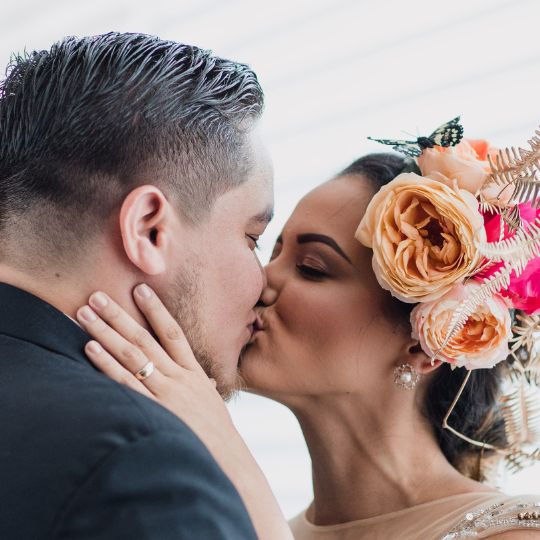Sealed with a Kiss, or Not
/08
by Jennifer
Cram - Brisbane Marriage Celebrant © 16 September
2024Categories: | Wedding Ceremony | Wedding Traditions
 Earlier this
week I solemnised the marriage of two people who
are clearly, obviously, blissfully (even giddily)
in love. And guess what. They didn't kiss. I knew
they weren't going to because it is always a
question I ask. In fact they didn't stand side by
side. They sat on opposite sides of my dining
table, with me at the end and their two witnesses
seated next to them.
Earlier this
week I solemnised the marriage of two people who
are clearly, obviously, blissfully (even giddily)
in love. And guess what. They didn't kiss. I knew
they weren't going to because it is always a
question I ask. In fact they didn't stand side by
side. They sat on opposite sides of my dining
table, with me at the end and their two witnesses
seated next to them.When I pronounced them married, he stretched his arm across the table (it's very wide) and she did the same, and they locked hands and eyes. Romantic and intense. And then he stood up, leaned over, and kissed her hand, to everyone's delight.
Kissing - why everyone
thinks it is a must include
BUT, here is the big but, it is NOT a legal requirement. You'll be just as much married if you don't choose to lock lips.
Unfortunately, not every celebrant knows this. Many years ago I overheard a conversation at a gathering of celebrants in which a celebrant of some years standing was expressing his frustration about a couple who he said he had almost to force them to kiss. Lots of nods and tutting from others. Until I asked a simple question. The reason for their reluctance became obvious. PDA's are a huge no-no in their culture.
So why do we assume
that kissing is mandatory?
Most people in Australia have little or no experience of a church wedding. Nor do they realise that there was a watershed moment sometime in about the 1970s - possibly to do with the importation of American soap operas on which weddings were a frequent part of story-lines - when Australia weddings pivoted from following English protocol to American, the most obvious being the switch to bridesmaids in first rather than following the bride. And, of course, the ubiquitous kiss!
If you go back in history there are three significant facts about kissing in marriage ceremonies that seem to have slipped through the cracks of folk memory.
1. Way back when, in Ancient Rome, marriage was a secular contract entered into by two families, and there were no handy EFTPOS machines or printed receipts, the accepted way of sealing a bargain or contract of any kind, was for the buyer and the seller to share a chaste, and public kiss. Basically, anyone witnessing that kiss could see that a deal had been done. Today, marriage is a secular contract entered into by two adult people, and recognised by the law of the land.
2. The Sign of Peace, originally referred to as the Kiss of Peace, is an ancient rite* that originated among the first Christians. In weddings, the first kiss was when the priest kissed the groom, who then kissed the bride. This was significant because in some places, clergy only greeted clergy, men only men, and women only women, while in other places, everyone was greeted. And then, it disappeared for centuries, only reappearing in Catholic Church services as part of the liturgical reforms initiated by Vatican II when it was restored to the Roman missal in 1970.
*so ancient, in fact, that the Irish word for “kiss,” póg, derives from the Latin “pax” thanks to this ceremony.
Interestingly, the Anglican Church of Canada marriage service includes right at the end, the minister saying "The peace of the Lord be always with you" to which the people reply "And also with you" followed by the comment, "The newly married couple may greet each other".
3. The Church of England wedding ceremony (on which our secular weddings are based) does not include a kiss! And never did. For those marrying in England and Wales, the service as per the 1662 prayer book, or the slightly updated version of it used in William and Kate's royal wedding, together with the service as per the year 2000 version of the Book of Common Prayer, don't include it. The priest declares that the couple is married and, in the updated and later versions joins their right hands and says Those whom God hath joined together let no man put asunder. Which, in case you've wondered, is why that kiss on the Buckingham Palace balcony was so significant!
The way it is in
Australia
However, the Marriage Act makes no mention of kissing. And where the Marriage Act is silent, you can be confident that there is no legal requirement.
So, if, for whatever reason, you do not wish to kiss, you don't have to.
Last word: If you do
kiss in your wedding, it is not a PDA
There is a reason for my frequent admonition to couples - not a rule, I say, just very strongly worded words of advice - No Tongue, No Bum, No Chewing Gum. And that also means no Dip (that's a dance move that requires lots of practice, so keep it for your amazing, choreographed first dance)
Related information

pullin0 Thingsm